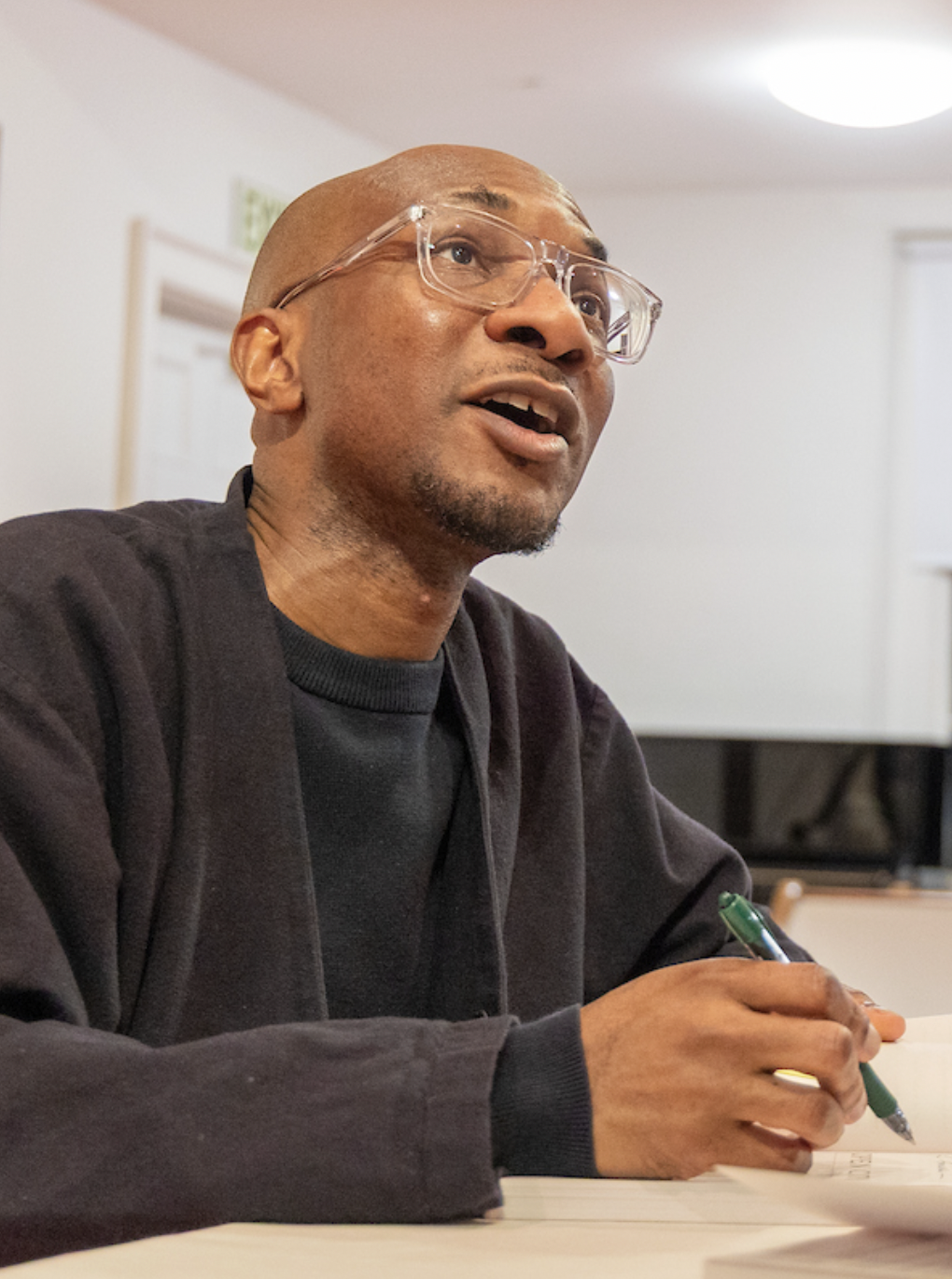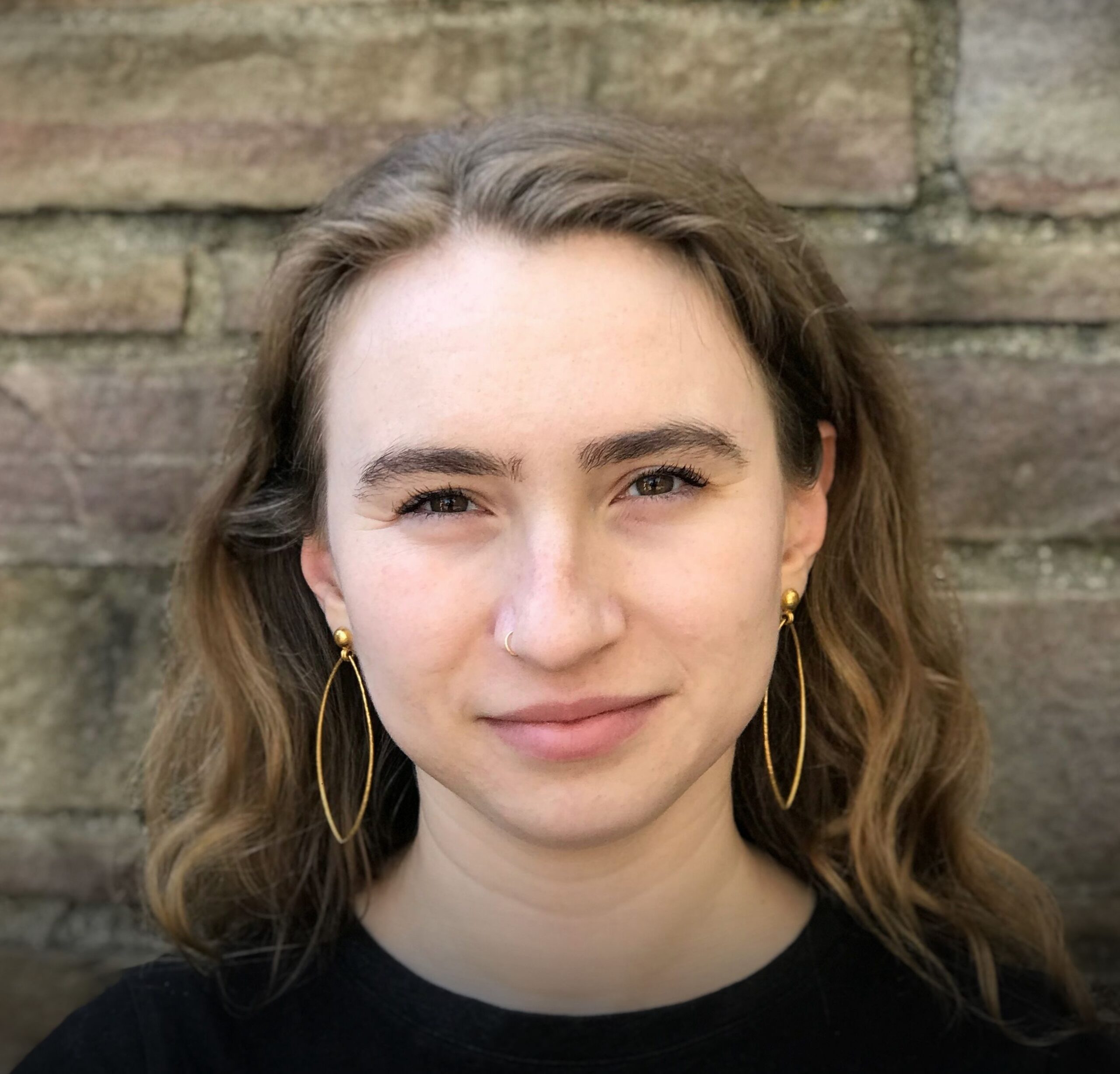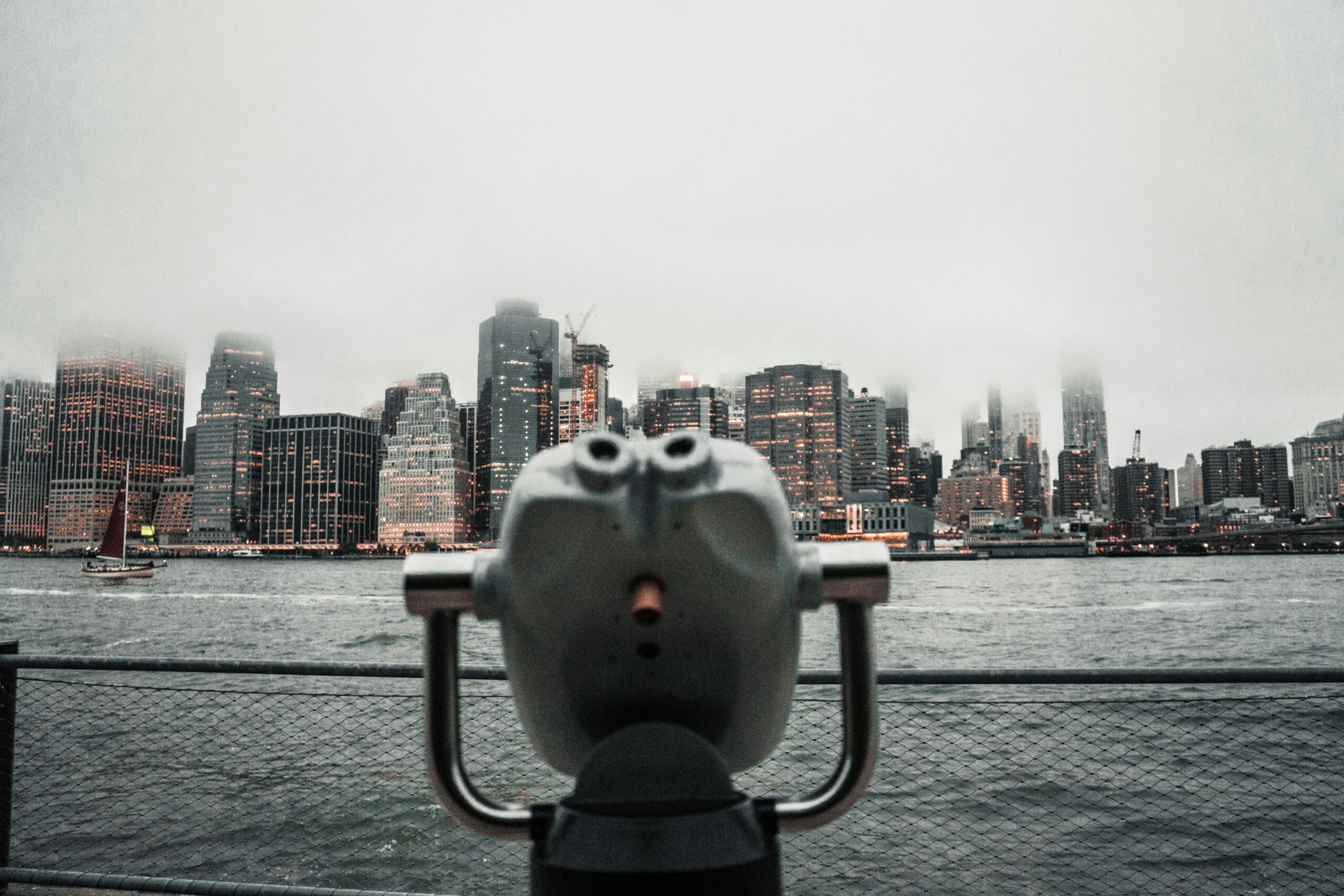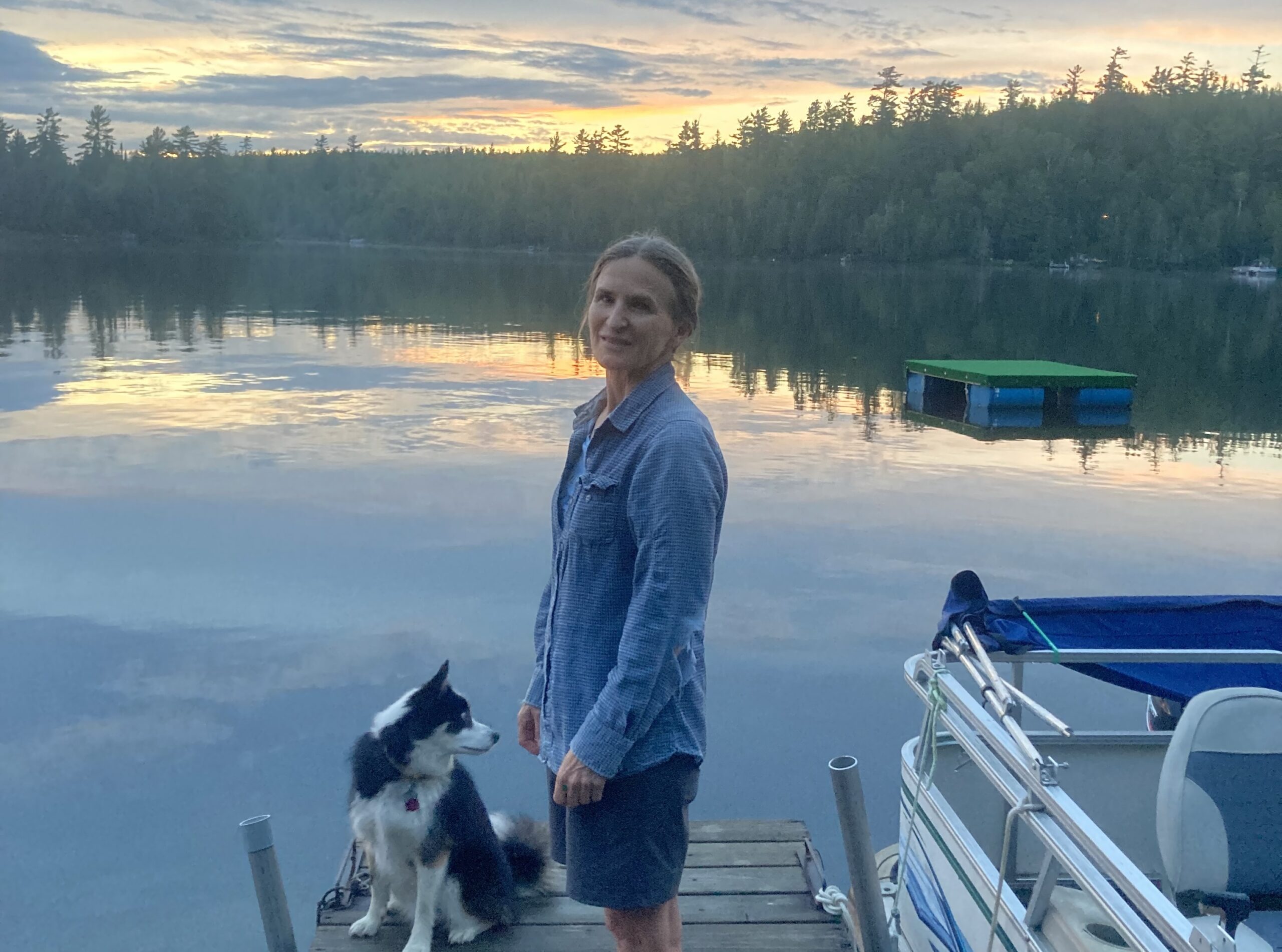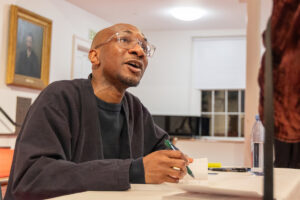
Teju Cole at LitFest 2025
For TEJU COLE, prose, poetry, and photography tug against and bleed into one another. At the tenth anniversary of Amherst College’s LitFest, on March 1, 2025, Cole spoke with The Common’s Editor in Chief JENNIFER ACKER about his novel Tremor, his approach to genre-bending, and the role of writers and photographers in bearing witness to catastrophe.
Jennifer Acker: I’d like to begin with your most recent novel, Tremor. The novel’s composition is remarkable for the unusual way its eight sections tangentially revolve around the narrator, a West African man named Tunde. Can you talk about how you arrived at the structure for Tremor?
Teju Cole: My approach to novel making is not plot-driven. What I’m interested in is patterning. The book has eight chapters, and the first three seem to have a continuity to them: they’re all in the third person. These chapters are about the rhythms of life for this person, a college teacher. But then we get to other chapters, and other things are happening. Chapter Five is actually just a lecture that somebody gives—somebody who turns out to be the protagonist, Tunde. Chapter Six is twenty-four first-person monologues, none of whom are Tunde. Chapter Seven is a Calvino-esque dream sequence about a city; it’s extremely abstract. It would be fair to describe the novel as fragmentary: It’s this story, that story, that recollection. It refuses to settle into correct form. Many different gestures are happening in this book.
I wrote a novel called Open City, published in 2011, and I have to tell you, the first two months of that novel’s life were very strange, because people said, “What’s this? Is it a novel?” Then there were a couple of high-profile positive reviews, and everyone agreed it was a novel.
Of course, that became a millstone around my neck. The self-imposed pressure I felt was having to write another book where people would say, “Is this a novel?” I really believe in the novel as an innovative form. Yet I didn’t want novelty for its own sake. There had to be something necessary in how I approached the narrating. For me, this was a puzzle to be solved, this work of arriving at the many different ways a character might give an account of what it means to be in the world.
JA: Was there a chapter or a section of the book that came first? What was the germ?
TC: The first thing I wrote ended up in the final chapter. There’s a couple of sentences from that very early passage that I ended up retaining.
It’s an account of Through the Olive Trees, by Abbas Kiarostami, the Iranian film director, made in a part of Iran that had been devastated by an earthquake. The story he tells is not about the earthquake but about the aftermath—about how people live on ruins because human beings have to live. I was just really enchanted by what it might mean to try to put this idea into prose: that we live on shaky ground.
JA: Tunde, the narrator, biographically runs in parallel to your life in some ways. Could you talk about your decision to create a narrator who resembles you in some important aspects, but certainly not in all of them? What limitations does that place on you? What opportunities does it open up?
TC: One limitation it places is that people are going to read it and think it’s me. So, if there’s something intimate or something unpleasant about Tunde, they’re going to think that’s me. This is what novelists do. We bleed in public. If I strive to make up something that has nothing to do with me, that is limiting, because I have to make up the whole thing from whole cloth and try to make it real. What I prefer to do instead is to take some of the most obvious things from my life and give them to Tunde. Now I’ve put you into this zone where you wonder, “Is this other thing also true?” But you can’t know. Half of it isn’t.
But having that firm armature of the apparently real just allows me to go deeper into what really interests me, which is how our thoughts shift from one thing to another. These are thoughts I’m inventing as I’m doing the writing. The fact that Tunde is a Nigerian American guy who lives in Cambridge and teaches at Harvard is not really interesting to me. It’s just the armature for exploring a place in the world. But I think it’s also important to assert that particular place in the world and not disavow it. Wherever you are is where you are—what does the world look like from there? If the world is not interesting from where you are, maybe you’re not thinking about it hard enough.
JA: Do you think the book’s fractured structure helps you undercut readers making too close a connection to you?
TC: That’s a very good question. It’s worth thinking about. When I’m reading, what I really respond to is that free zone of, “What are you doing? What’s going on here?” I love to read a thing and feel a mind moving. It could be any subject. I could read a novel that describes a room. As long as the mind that’s writing it is moving, then everything is present for me inside that room. That’s what I admire, and consequently that’s what I aspire to. I wanted every page of this relatively slim book to feel like, “Oh, this person is not on autopilot. There’s a mind at work here.” I am not really worrying so much about whether people think the protagonist is me.
When we narrate ourselves to ourselves, we’re constantly shifting. Sometimes you think of yourself as “you.” You have a job interview, you’re in front of the mirror, and you’re like, “You better not fuck this up.” Meanwhile, you also think of yourself as “I” often: “I’m going to be as brave as possible when talking to HR and making my salary demands.” But sometimes we even feel ourselves in the third person. There’s somehow that distance. We’re comfortable with these different points of view, these many different cameras that help us to look at ourselves.
For me, one of the interesting things about writing this book is that I wanted to write a book that was not formally immediately comparable to any other novel that I know; and I don’t think it is. Yet, it’s not at all difficult to read, because we’re good readers. We can see, “Oh, something else is happening in this chapter.” As readers we think, “Okay, I see what you’re doing.” Then we start following the mind at work. That idea that “experimental” doesn’t necessarily mean “difficult” has been an important one for me to explore.
JA: Tunde travels a lot in this book, and you travel a lot. Why is travel important to you? Have you been to a place in recent memory that has impacted you in a significant way, maybe changed your mind about something?
TC: Travel can be such a conduit to moral formation. It can be just for fun, but witnessing others helps you to really understand that they’re there. Other people are not just concepts. I like going to places and seeing things for myself.
This is slightly digressive, but Tunde and his lover, early on in the novel, have this big argument in Lahaina, in Hawaii. I’ve never been to Hawaii, but there’s a whole passage of the book that’s set there. And very strangely, maybe a month or a couple of months before the book was published, Lahaina burnt down completely. It just did not exist anymore. That my book is one of the places where that place exists as it was is spooky. There are places I’ve written about, scenarios I have described, that were utterly changed later on. It’s happened more than a few times.
I love this question about places that have had a huge impact on me. I will talk about three that have been on my mind a lot lately. One was visiting Ramallah and going through the checkpoint in Qalandia into Jerusalem. They really, really hassled us. But it was almost nothing compared to the hassle that we could see in the other line, of Palestinians who had the right paperwork. That’s been on my mind a lot, and it helps me think about what’s going on in Palestine in not at all abstract terms.
Another thing I’ve been thinking a lot about was, in Greece, in the course of reporting a story, I went to a village north of a city probably very few people here have even been to. I flew to the city, Alexandroupoli, and then traveled by car an hour to a village in the mountains up there called Sidiro. Sidiro is about thirty minutes from the Turkish border with Greece. When people are crossing the river Evros, trying to reach Greece from Turkey, many of them are harassed by Greek or EU forces. And many of the drown. When the bodies of the drowned are retrieved, they’re sent to Alexandroupoli to be identified. Sometimes they are identified. But often these people are not carrying IDs, because they don’t want to be identified, and so they cannot be identified. After all avenues have been exhausted for finding out who these people are, the chief medical examiner of Alexandroupoli calls the chief imam of Sidiro, which is a Muslim Greek village. The chief imam retrieves the bodies and buries them on a hilltop in northern Greece just outside his village, in a cemetery where you have rows and rows of white gravestones with no names on them. When I heard about this—and this is the privilege of travel—I thought, “I have to go there.” I think these journeys are important to me so that the news of people dying on the border does not become an abstraction. I wanted to take some flowers to that cemetery and be there on behalf of people whose loved ones are buried there, buried there without the knowledge of their families.
My third answer to the question about place is lighter and much more recent. I went to the Emily Dickinson Museum yesterday. I’m a fan of that notable Amherst native. Big fan. When you go places, it confirms some of what you know, and there’s stuff you cannot know if you have not gone to see it for yourself. For example, I assumed that the Homestead and The Evergreens were much closer to each other. It’s almost a trivial fact. I thought maybe they were twenty-five yards apart, but the distance is actually more like one hundred yards. You would have to put on a coat in order to go visit Susan in the other house.
I’m currently in the middle of writing an essay about Emily Dickinson, and seeing the space gives me more context, in addition to all the Dickinson poems I’ve read.
I’m no Dickinson scholar, but I knew that there were Irish people who worked in the Dickinson house as domestic servants. And, of course, Amherst had freed Black people, and I was told that there were Black people who were working for the family outside of the house, in the fields and gardens. There was something interesting about standing in Emily Dickinson’s room, where she wrote her poems, and knowing that, on that side of the house, if you go down that hallway, there’s the servants’ quarters, and they’re Irish. And then there are people outside in a bigger concentric circle who are Black people who are working for the family—in what state of indenture, I do not know. I never approach a situation with the idea of valorizing anyone or any place, but I instead take all the evidence into consideration and try to say something worth saying about it.
JA: I want to ask you more about Dickinson. You’ve been thinking a lot about her poems. You’ve read them all. What is it that speaks to you in these poems?
TC: The Variorum Edition of her poems, by [Ralph W.] Franklin, comes in three volumes, and there are 1,800 poems. It was a solid six weeks of my life reading every single one of them. What that particular enterprise gave me was a sense that we think we know Emily Dickinson’s poems because we know 100 of them, the most anthologized ones. For many of us, it’s because we know ten of them. But meanwhile, there’s 1,800 poems. It means we have been at the mercy of anthologists. When you go through all the poems, well, first of all, what you feel is rage. You think: I’ve been lied to, because there’s some really good shit in here that never gets into anthologies!
JA: Editors cannot be trusted.
TC: Well, I mean, they can be trusted to represent their own inclinations, which may not perfectly match with mine. The abiding effect was that she is more deeply strange, more deeply gifted than I could have imagined. She had the tremendous good fortune of not being published in her lifetime, which meant that she could work this peculiar vein of insight without obstruction from those who thought they knew better. It’s an entire body of ingenious work, no filter. They are some of the strangest and most original poems that I have ever encountered.
I think I’ll just keep going back to them and trying to understand what they’re up to. Her enterprise is also a model of what you can do if you are stubborn enough to not let other people get in your way. Confidence is different from certainty. What if it sounds weird? What if it doesn’t make sense? What if, in any given poem, she’s giving you a bunch of variants for particular words, but is refusing to actually choose between those words, so that the poem becomes an open text with any number of permutations?
She wouldn’t put the word “experimental” on that openness. I think her attitude’s just: “That’s what the poem needs.” Now, that is clearly an innovation that print cannot accommodate, but that a manuscript can. She really flourished in the affordances of the manuscript. I’m geeked to be here in her Amherst. This is Disneyland for a certain type of poetry geek.
JA: Have you been inspired to write poetry yourself?
TC: No. I’m not a poet, but I do read probably more poetry than anything else. This is advantageous to me. I have such intimidating regard for what poets do, what they do through both their sensitivity and their long years of training, that I am not going to inflict bad or unfinished poems on the world. I’ll admit that, in the past few years, if something has wanted to come to me as a poem, I’ve written it as a poem. But I don’t publish it. Maybe if I go at this for another dozen years, maybe there’ll eventually be something worth showing.
But right now, the advantage is that there’s this nourishing spring of literature that can then show up in the other work I do. Reading poetry and doing that type of listening affects the photography I make. It affects the prose I write. When my students sometimes think that “poetic prose” is purple prose—overwrought, with the big words and gestures that we think of as poetic—I tell them that poetic prose is precise prose. The poetry lies in the precision, the poetry is in somehow translating sensation and experience into the most forensic language available. Poetry is a feeling worth getting down, a process that begins with attending and listening. So that’s what poetry does for me.
JA: Were you introduced to poetry as a child, or as a young person? I’m wondering what some of your early linguistic influences were. What kinds of things were given to you? What were the languages and the stories that you were hearing? What fed into your early ideals about writing and reading?
TC: Growing up in Nigeria, I was good at school, particularly good in English. But in Nigeria, in high school, you had to take nine subjects in your final three years, and you had to choose between literature and geography. But I was the top student in geography, and I wasn’t going to give it up. Those of you who have immigrant parents are going to be very familiar with this. If you’re good at school in Nigeria, there’s like three professions worth pursuing: doctor, lawyer, engineer. So, at some early age, because I was doing well in my science classes, it was decided, “Okay, you’re going to be a doctor.” But my great love was art, from when I was a kid. When I was an undergrad, I was an art major. My senior thesis in college was a sculpture show. I was so busy both fulfilling pre-med requirements and being an art major that I didn’t take any literature classes. (And I did give medicine a good go. Even as far as my mid-twenties, the doctor plan was still the thing. I’m a medical school dropout.)
Anyway, the point of all this is that I haven’t studied literature formally since I was in middle school, and I’ve somehow ended up as a professor in an English department. Harvard will hire literally anyone these days!
But, to return to your question about early literary influences: There was a summer in my early twenties when I was reading certain books, and that summer it hit me like a lightning bolt that a book is not simply something that exists. It’s something that’s made, that an author carefully prepares the effects of, so that the book can act on you. And I remember what I was reading. It was The Catcher in the Rye, The Old Man and the Sea, and A Portrait of the Artist as a Young Man. I started to think about making literature. And then, in my late twenties, I found the language I wanted to make literature in: conveying the maximum complexity of thought with the leanest and simplest language that could support that thought. And I was on my way.
JA: How did you find the courage to leave a sure career like medicine and pursue the arts?
TC: Oh my God, that’s an easy one to answer: Survival. Man, I was depressed and couldn’t function. I was having such a hard time. I was like, “This is killing me.” I wanted to be a doctor, but I didn’t want to be a medical student. For many years afterward, I thought, “What’s wrong with me? Am I lazy?” And not until even later did I realize that, if I’m doing what I love and what activates me, I’m not lazy. I’ll work. I will happily work twelve hours a day, and I often do, doing what I’m passionate about. I just get disorganized and unfocused if it’s something that is not energizing me. So that’s how that happened. Oh my God, it was such a family disaster—“What do you mean you’re leaving medical school?” But it’s all right now.
JA: I’d like to ask about your photography—you are both a photographer and a photography critic. Can you talk about how your interest in photography began? When did you first start taking pictures? What has been the evolution of that practice?
TC: It was around the time I found my language in writing, in my late twenties. I started with a very basic three-megapixel digital camera, just trying to find what was in the world that was interesting. And then later on, for a long time, for more than a decade, I only photographed in film. I’m self-taught, but I think a lot of my photography education was just being really interested in what has been done already—really studying and developing my eye, going to shows, collecting a lot of photo books, taking some photo workshops with established photographers, and then very, very slowly arriving at this style. Which, again, is something about simplicity that carries a lot of mystery and complexity in it. They’re not very dynamic photos, but they’re looking for the epiphany in the everyday. I have friends who make fun of me. They say, “Hey, have you photographed any corners lately? Here’s this corner of this room. Why don’t you photograph that?” Because I like to photograph as if there’s almost nothing there, and sometimes, when I’m lucky, there’s something there.
JA: And how did it evolve that you began writing short essays to accompany these photographs? Blind Spot is this remarkable collection of photographs, but each one is accompanied by a short textual piece. When did you begin doing that pairing, and what was the goal in pairing those two things together?
TC: I had done Every Day Is for the Thief, which was published in 2007, and that was fiction, a novella, and there were photos accompanying it. I made those photos in a style different from my own style—they were much more journalistic photos, in the style of this unnamed narrator. But if it’s fiction, what are the photos doing? They’re almost evidentiary or testimonial.
Then there was a major breakthrough for me in 2014 when I went to Switzerland for the first time and I was photographing the Swiss landscape and trying to understand this place that is one of the most photographed tourist destinations in the world. The rise of tourist photography is intimately connected to Switzerland, and both are connected with the conquering of the Alps. The first guidebooks, published by Baedeker, were for Switzerland, late in the nineteenthth century. I was coming to this confluence of factors belatedly and saying, “What can you say inside this over-touristed space?” I think it was a real breakthrough for me to think about writing quite poetically, quite freely about sensations that came from the history of the place, but that also came from thinking about photography. And it was very encouraging for me to send that off to a magazine and have a sequence of photos be published with it. That magazine was The Common. So that was a very signal moment for me.
JA: I noticed that one of the photographs we published is the cover of Blind Spot.
TC: Yes. And Blind Spot was published three years later, so that was the genesis of that project.
JA: Say you’re going to a new place and you have both your pencil and your camera. Is there something about the environment that speaks to you and makes you feel “I want to photograph this,” as opposed to “I want to write about this”? Is the answer always both? Or is there some other thought process?
TC: Usually I would be doing both. Right now, I’m taking a little sabbatical from the camera in order to better understand what my next move needs to be. But usually I go with both and stay agnostic about what might happen in a place. I’ll go to a place and take any opportunity to make photographs there—only after I get home will I realize if I have anything. I never publish a photo because it’s of an important subject. The photo itself has to speak, has to have aura and energy. And the same goes with writing. What’s important is to pay attention. Something might happen. You don’t know yet, but you’re paying attention.
JA: In Black Paper, one of your essay collections, you write about what it means to witness catastrophe through photography. Could you speak more to how writing can be a way of capturing the fragility of our political moment, or the balance of photography and writing in this act of witnessing?
TC: There’s a thing that’s often said that has been attributed to various people—one of them is Chairman Mao, who was asked what he thought of the French Revolution. And he said, “It’s too soon to tell.” There is a necessity of bearing witness to our times, but there’s something dangerous about jumping on top of the most urgent thing and having that be the work. It’s not easy to resolve, because you have a certain responsibility, but you also know that the work that emerges from that hurried immediacy can be very flawed. So it’s sometimes important to give things time, and sometimes important to find a way of being oblique. Photography can tell us something about catastrophe and can certainly be a witness in a way that also leads to political action. Of course, writing can do that as well—that’s why we have reporters and journalists.
But, for those of us who are also doing work that is adjacent to poetry, I think it’s so important for us to understand the way that literature can be a necessary reprieve from what I think of as “op-ed brain.” We don’t always have to do op-eds—we can respect the poetic impulse and try to find the deeper thing in our writing and our reading.
I’ve been very moved by what’s been going on these past weeks with these exchanges of the hostages. The many, many Palestinian people held hostage by Israel, the Israeli people held hostage by Hamas. Of course, they don’t call the Palestinian people hostages, and that’s its own political story, but they’ve been held hostage, because they’ve not actually committed any crime. And then there’s this gutting, heartbreaking thing of the return of dead bodies, because human beings need to mourn and they need to grieve, and sometimes you need the body. And again, this is something that is happening and has happened on both sides of that equation.
I didn’t need to write an opinion piece about that. What I wanted to do was go back to the twenty-fourth book of The Iliad and read the account of King Priam going to the ships on the shore where Achilles refuses to release the body of Hector—where Achilles says of Hector, “He’s my enemy, and he has killed Patroclus, my beloved. And I will not give up his body. I’m going to feed it to the dogs.” And King Priam, at great personal risk, shows up with a ransom and falls on his knees and clasps Achilles’ hand. Homer says (I paraphrase) that Priam was in the unique position of being the only person who ever clasped and kissed the hands of the man who murdered his beloved son. He begged him and said, “I’m an old man, and I know your father’s an old man, and I know he misses you very much. Please take pity on me and release my son to me.” And they both began to weep. Priam is weeping for Hector, and Achilles is weeping for his own father, who’s still alive but far away from Troy, and he is weeping for Patroclus. And Homer says, “When they had had their fill of weeping, Achilles consented to release the body.”
This has so much to tell us. It doesn’t give us a political solution, but what it tells us is that we cannot forget the human element. I think, sometimes, the role of the poet, the writer, the artist is to say, “The thing that is taking our attention right now is a very big thing. You’re not wrong. We’re not going to gaslight you and say it’s not important. But pause, take a breath. We are not the first to face a crisis. Let us take refuge in what has been written for us and on our behalf.” That is what I’ve been reading all week. I’ve been reading that account and thinking through it and taking some cold consolation in the fact that even if all you are getting back is a dead body, at least you get to do the funeral and continue life.
JA: Before we end, I want to ask if you have a recommendation or two—not to put you too much on the spot—of an Emily Dickinson poem that we should all go home and read.
TC: Let me think of a poem that is not one of her most famous. There’s one that goes, if I can remember it, “I fit for them— / I seek the Dark / Till I am thorough fit. / The labor is a sober one / With this sufficient sweet / That abstinence of mine produce / a purer food for them, if I succeed, / If not, I had / The transport of the Aim—.”
JA: Wow.
TC: Yeah. The thing about her is that that’s only two quatrains, and you’re going to spend the rest of the week saying, “The fuck does that mean?” It is actually incredible. A phrase like “If not, I had the transport of the Aim”: Language ennobles us, and she’s one of the places to go find it in its most quintessential forms.
JA: That was beautiful. Thank you so much.
TC: Thank you. Thank you.
Teju Cole is a professor of creative writing at Harvard. He is the author of the essay collections Black Paper and Known and Strange Things, the novella Every Day Is for the Thief, and the novels Open City and Tremor. He was the photography critic for The New York Times Magazine from 2015 to 2019 (a position he originated).
